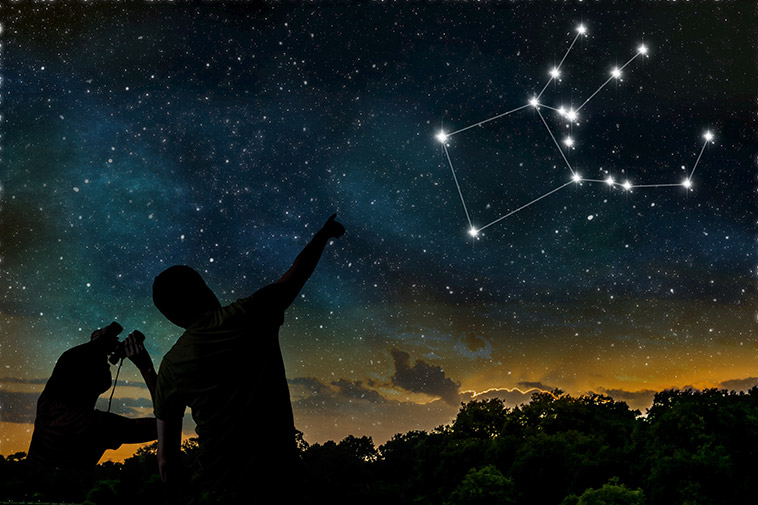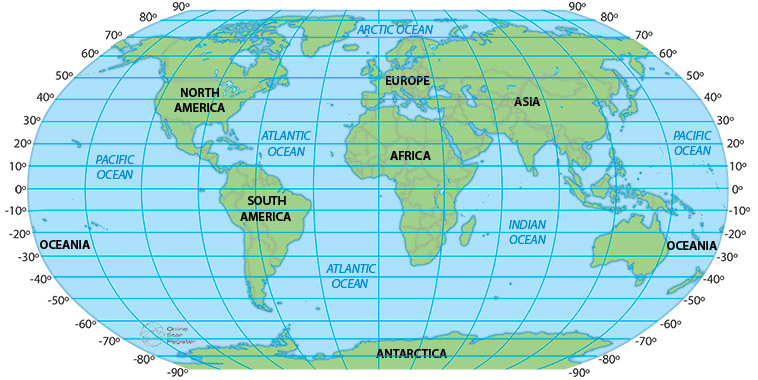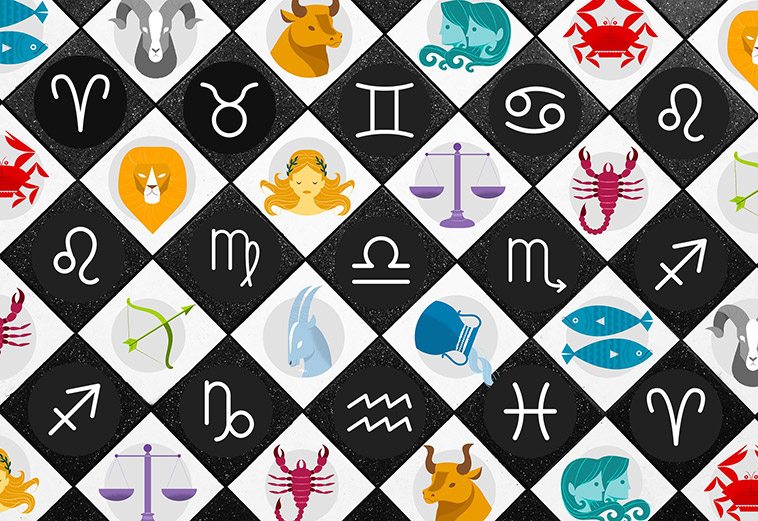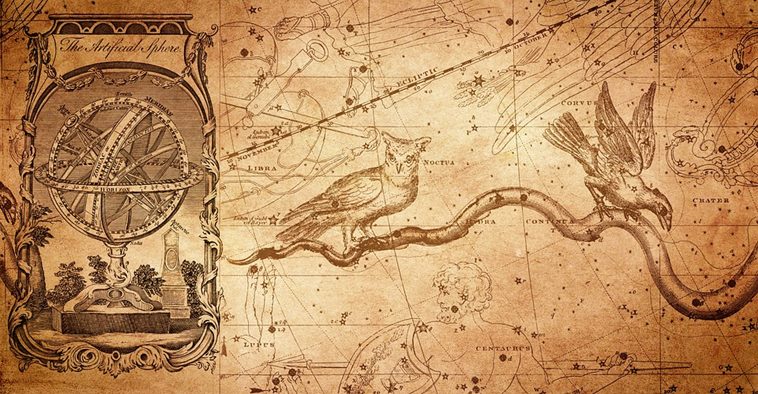About
Everything you need to know about the 88 constellations & 12 zodiacs
We have probably all heard of the Big Dipper, the Little Dipper and the 12 zodiacs, but did you know that modern astronomers have divided the sky into 88 constellations? Read on, learn all you need to know about constellations and zodiacs, and find out which constellations you can see from your location!

Which constellations can you see from your area?
Whether you can see a constellation or not depends on your location. Certain constellations are visible from most parts of the world, while for others, you might have to travel to the other side of the globe. On the map below you can easily find out which latitude you are on.
Latitudes are a series of imaginary parallel lines that run east to west around the globe, indicated by degrees. The equator is at 0 degrees while the North Pole is at +90° (90 degrees north) and the South Pole at -90° (90 degrees south). New York, for example, lies at +40°, London at +52° and Rio de Janeiro at about -23°.

Find out easily which latitude you are on with our World Latitude Map
Find out easily which latitude you are on with our World Latitude MapNow that you know which latitude you are on, you can find out if you can view a constellation from your area. In the table below we’ve listed the constellation family. In addition, we have listed the best month to see the constellation. You can find out more about each constellation by clicking on its name.
| Constellation | Family | Latitudes | Best Seen |
|---|---|---|---|
| Andromeda | Perseus | +90° to -40° | November |
| Antlia | Lacaille | +45° to -90° | April |
| Apus | Bayer | +5° to -90° | July |
| Aquila | Hercules | +85° to -75° | September |
| Aquarius | Zodiac | +65° to -90° | October |
| Ara | Hercules | +25° to -90° | July |
| Aries | Zodiac | +90° to -60° | December |
| Auriga | Perseus | +90° to -40° | February |
| Bootes | Ursa Major | +90° to -50° | June |
| Caelum | Lacaille | +40° to -90° | January |
| Camelopardalis | Ursa Major | +90° to -10° | February |
| Capricornus | Zodiac | +60° to -90° | September |
| Carina | Heavenly Waters | +20° to -90° | March |
| Cassiopeia | Perseus | +90° to -20° | November |
| Centaurus | Hercules | +30° to -90° | May |
| Cepheus | Perseus | +90° to -10° | October |
| Cetus | Perseus | +70° to -90° | December |
| Chamaeleon | Bayer | 0° to -90° | April |
| Circinus | Lacaille | +20° to -90° | June |
| Canis Major | Orion | +60° to -90° | February |
| Canis Minor | Orion | +85° to -75° | March |
| Cancer | Zodiac | +90° to -60° | March |
| Columba | Heavenly Waters | +45° to -90° | February |
| Coma Berenices | Ursa Major | +90° to -60° | May |
| Corona Australis | Hercules | +40° to -90° | August |
| Corona Borealis | Ursa Major | +90° to -50° | July |
| Crater | Hercules | +65° to -90° | April |
| Crux | Hercules | +20° to -90° | May |
| Corvus | Hercules | +60° to -90° | May |
| Canes Venatici | Ursa Major | +90° to -40° | May |
| Cygnus | Hercules | +90° to -40° | September |
| Delphinus | Heavenly Waters | +90° to -70° | September |
| Dorado | Bayer | +15° to -90° | January |
| Draco | Ursa Major | +90° to -15° | July |
| Equuleus | Heavenly Waters | +90° to -70° | September |
| Eridanus | Heavenly Waters | +60° to -90° | December |
| Fornax | Lacaille | +50° to -90° | December |
| Gemini | Zodiac | +90° to -60° | February |
| Grus | Bayer | +35° to -90° | October |
| Hercules | Hercules | +90° to -50° | July |
| Horologium | Lacaille | +20° to -90° | December |
| Hydra | Hercules | +60° to -90° | April |
| Hydrus | Bayer | +5° to -90° | December |
| Indus | Bayer | +25° to -90° | September |
| Lacerta | Perseus | +90° to -35° | October |
| Leo | Zodiac | +90° to -65° | April |
| Lepus | Orion | +60° to -90° | February |
| Libra | Zodiac | +65° to -90° | June |
| Leo Minor | Ursa Major | +90° to -45° | April |
| Lupus | Hercules | +35° to -90° | June |
| Lynx | Ursa Major | +90° to -35° | March |
| Lyra | Hercules | +90° to -40° | August |
| Mensa | Lacaille | 0° to -90° | January |
| Microscopium | Lacaille | +45° to -90° | September |
| Monoceros | Orion | +75° to -85° | February |
| Musca | Bayer | +10° to -90° | May |
| Norma | Lacaille | +30° to -90° | July |
| Octans | Lacaille | +5° to -90° | October |
| Ophiuchus | Hercules | +80° to -80° | July |
| Orion | Orion | +85° to -75° | January |
| Pavo | Bayer | +15° to -90° | September |
| Pegasus | Perseus | +90° to -60° | October |
| Perseus | Perseus | +90° to -35° | December |
| Phoenix | Bayer | +30° to -90° | November |
| Pictor | Lacaille | +25° to -90° | February |
| Piscis Austrinus | Heavenly Waters | +50° to -90° | October |
| Pisces | Zodiac | +90° to -65° | November |
| Puppis | Heavenly Waters | +40° to -90° | March |
| Pyxis | Heavenly Waters | +50° to -90° | March |
| Reticulum | Lacaille | +20° to -90° | January |
| Sculptor | Lacaille | +50° to -90° | November |
| Scorpius | Zodiac | +40° to -90° | July |
| Scutum | Hercules | +70° to -90° | August |
| Serpens | Hercules | +80° to -80° | July |
| Sextans | Hercules | +80° to -80° | April |
| Sagitta | Hercules | +90° to -70° | September |
| Sagittarius | Zodiac | +55° to -90° | August |
| Taurus | Zodiac | +90° to -65° | January |
| Telescopium | Lacaille | +30° to -90° | August |
| Triangulum Australe | Hercules | +15° to -90° | July |
| Triangulum | Perseus | +90° to -50° | December |
| Tucana | Bayer | +15° to -90° | November |
| Ursa Major | Ursa Major | +90° to -30° | April |
| Ursa Minor | Ursa Major | +90° to -10° | June |
| Vela | Heavenly Waters | +30° to -90° | March |
| Virgo | Zodiac | +80° to -80° | May |
| Volans | Bayer | +10° to -90° | March |
| Vulpecula | Hercules | +90° to -55° | September |
TIP: You can also install the free OSR Star Finder App, available for iOS and Android, to find out which constellations are visible from your area.
The Zodiac and Other Constellation Families
Constellation families are collections of constellations that share a defining characteristic like proximity on the celestial sphere, common historical origin, or a common mythological theme. In 1975, astronomer Donald Howard Menzel gathered several traditional groups and adjusted them so that his handful of groups covered all 88 of the modern constellations. The constellation families are the Ursa Major Family, the Perseus Family, the Hercules Family, the Orion Family, the Heavenly Waters, the Bayer Family, the La Caille Family, and last but not least, the famous Zodiac.

The 12 Signs of the Zodiac (Image credits: Pixabay)
25 Facts About the Zodiac
By definition, the Zodiac is a circle consisting of twelve, 30° divisions, that are centered upon the path of the Sun over the year. The paths of the Moon and visible planets are also here and stay close to the zodiac belt. The zodiac belt is made up of the twelve zodiac signs. That is why you may hear people say the moon is in Aries, or Gemini is close to the sun. The zodiac signs make up horoscopes. Horoscopes are predictions made based on the position of the zodiac sign when a person was born. Some people live their lives according to the predictions of their horoscopes. Below we’ve listed 25 more facts about the zodiac.
1. The earliest known astrological records date back to Babylon, 1645 B.C. The earliest horoscope was around 410 B.C.
2. The origins of the zodiac can be traced back to Egypt (timekeeping and the science behind the calendar). Greece also contributed with Ptolemy being the author of both astrological and astronomical texts. Roman “learned” men (including two emperors) wrote laws and counseled people based on the stars.
3. The word Zodiac comes from the Greek language, and translated, means animals. However, not all the signs of the horoscope are made up of animals.
4. The Zodiac’s signs are based on celestial constellations that map out their patterns. Each zodiac falls into one of four categories; Air, Water, Earth, and Fire.
5. According to astrology, the date you were born determines your zodiac element. This element will help keep your life in balance, determine your compatibility with others, and influence your personality.
6. The air signs are; Gemini, Libra, Aquarius. People born under the air sign tend to be smart, but also unpredictable, and elusive.
7. The water signs are; Cancer, Scorpio and Pisces. These people tend to be very emotional, sensitive, and in tune with others.
8. The earth signs are: Taurus, Virgo, Capricorn. These people tend to be down to earth, dependable, and stable.
9. The fire signs are; Aries, Leo, Sagittarius. These people get things done, are passionate, and follow their instincts.
10. Astrology is more in-depth than most people realize. Aside from their birthday, the location of the Sun to the Earth and time of their birth is also important.
11. The zodiac is found in medieval stained glass. An example of this would be the Angers Cathedral located in France. The stained glass located inside the church has a representation of all 12 zodiac symbols.
12. The celestial zodiac has its own special glow called the Zodiacal light. This faint, triangular-shaped soft light glows white in the night sky. The glow comes from the sun as it travels along the path. It can be best seen after sunset in the spring, and before sunrise in the autumn.
13. Although the zodiac is divided up into twelve equal parts, the sun does not spend an equal amount of time in each sign. For example, Virgo takes up five times as much ecliptic longitude as Scorpius, leaving the others short.

Image credits: Pixabay
List of 12 Zodiac Signs
If you are born between these dates, you are…?
- Date: March 21 – April 19th
- Sign: Ram
- Traits: Active, Demanding, Determined, Effective, Ambitious
- Date: April 20th – May 20th
- Sign: Bull
- Traits: Secure, Subtle Strength, Appreciative, Instructive, Patient
- Date: May 21st – June 20th
- Sign: The Twins
- Traits: Communicative, Indecisive, Inquisitive, Intelligent, Changeable
- Date: June 21st – July 22nd
- Sign: Crab
- Traits: Emotional, Diplomatic, Intense, Impulsive, Selective
- Date: July 23rd – August 22nd
- Sign: Lion
- Traits: Ruling, Warm, Generous, Faithful, Initiative
- Date: August 23rd – September 22nd
- Sign: The Virgin
- Traits: Analytical, Practical, Reflective, Observant, Thoughtful
- Date: September 23rd – October 22nd
- Sign: The Scales
- Traits: Balance, Justice, Truth, Beauty, Perfection
- Date: October 23rd – November 21st
- Sign: Scorpion
- Traits: Transient, Self-Willed, Purposeful, Unyielding
- Date: November 22nd – December 21st
- Sign: The Centaur
- Traits: Philosophical, Motion, Experimentation, Optimism
- Date: December 22nd – January 19th
- Sign: The Goat
- Traits: Determined, Dominant, Persevering, Practical, Willful
- Date: January 20th – February 18th
- Sign: The Water Bearer
- Traits: Knowledgeable, Humanitarian, Serious, Insightful, Duplicitous
- Date: February 19th – March 20th
- Sign: The Fish
- Traits: Fluctuating, Depth, Imaginative, Reactive, Indecisive

Image credits: Pixabay
20 Facts About Constellations
1. The word “constellation” comes from a Latin term meaning “set with stars.”
2. Farmers were the first to use the constellations. In some areas, the changing of seasons was very subtle. Farmers depended on the stars for planting and harvesting.
3. Astronomers have divided the sky into 88 different constellations.
4. We know the constellations have been around for centuries. Historical records in 4000 B.C. (Mesopotamian culture) refer to these bodies of stars. Homer’s epic poem, The Odyssey, refers to the constellations. Eudoxus of Cnidus wrote about 43 constellations 400 years later.
5. In 150 A.D., Alexandrian astronomer Ptolemy wrote The Almagest. This book was a collection of astronomical data. Ptolemy claimed that the data came from Babylonia in the 8th century B.C.
6. The stars are broken up into groups. The 21 Northern Constellations are; Andromeda, Aquila, Auriga, Boötes, Cassiopeia, Cepheus, Corona Borealis, Cygnus, Delphinus, Draco, Equuleus, Hercules, Lyra, Ophiuchus, Pegasus, Perseus, Sagitta, Serpens, Triangulum, Ursa Major and Ursa Minor.
7. There are 17 Southern Constellations; Ara, Carina, Puppis, Vela, Canis Major, Canis Minor, Centaurus, Cetus, Corona Australis, Corvus, Crater, Eridanus, Hydra, Lepus, Lupus, Orion and Pisces Austrinus.
8. Astrology has its own set of 12 Zodiacal Constellations; Aries, Aquarius, Cancer, Capricornus, Gemini, Leo, Libra, Pisces, Sagittarius, Scorpius, Taurus and Virgo.
9. In 1536, German globe maker Casper Vopel added two more constellations to the list. They are called; Coma Berenices and Antinous, which merged into Aquila in 1930.
10. In Ancient Greek, they did not name any constellations with the southern stars. In 1589 Dutch astronomer Plancius filled the southern celestial void. He created, Crux and Triangulus Antarcticus. He went on to create several more constellations.

11. The Greeks are responsible for naming the constellations. These names came from their mythological heroes and legends.
12. Seafaring ships used the stars for navigation. Polaris (The North Star) and Ursa Minor (Little Dipper constellation) were used to figure latitude (North/South).
13. In the Hindu culture, the Nakshatra is the term for lunar mansion. A Nakshatra is one of 27 (sometimes 28) sectors along the ecliptic. Their names are related to the most prominent patterns of stars in their respective sectors.
14. Each constellation has ties to a mythological Greek story. These stories often involve angry gods and mysterious beings.
15. The constellations are made up of stars that are near and far. Some of the stars shine bright if they are close to the Earth. Others shine bright because they are massive stars.
16. Not everyone can see all the constellations. Some constellations cannot be seen because of their location. In addition, the season of the year determines which constellations may be seen.
17. Hydra is the largest constellation by area. It takes up 3.16% of the sky.
18. The smallest constellation is Crux. It only takes up 0.17 percent of the sky.
19. The Big Dipper and Little Dipper are considered asterisms. An asterism is a small pattern of stars found within a constellation.
20. Twenty two different constellation names start with the letter “C”.
The next time you are gazing into the night sky, take some time to look for any one of these constellations and zodiacs. They are beautiful and fascinating. Also, you can now name your own star in any constellation in just a few clicks. Name the star, view it in 3D and look it up with the OSR Star Finder App!
